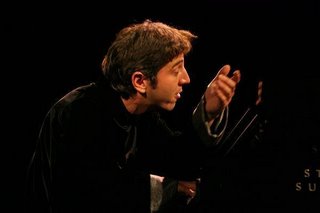 The excitement of the audience present for the Fazil Say recital on a gorgeous Sunday afternoon somehow did not translate into sheer numbers of attendees: Shriver Hall looked surprisingly empty for what promised to be one of the most exciting concerts in their Piano Celebration series. But perhaps it was for the better because much of that excitement evaporated the second it was announced that Mr. Say would not be playing The Rite of Spring (technical problems with the second piano) but instead - “what more could you ask for” - the Mus(s)orgsky Pictures at an Exhibition. The rhetorical question by the announcer was unfortunate because everyone in the audience must have had the answer read: the originally planned Stravinsky, for one, would be something we would have wished for more. Alas, one makes due with what is given – and to be fair, a Pictures performance from Say is a pleasant prospect – especially since I’ve heard that work live only once before in what turned out to be a terminally boring performance of Kissin’s in Munich.
The excitement of the audience present for the Fazil Say recital on a gorgeous Sunday afternoon somehow did not translate into sheer numbers of attendees: Shriver Hall looked surprisingly empty for what promised to be one of the most exciting concerts in their Piano Celebration series. But perhaps it was for the better because much of that excitement evaporated the second it was announced that Mr. Say would not be playing The Rite of Spring (technical problems with the second piano) but instead - “what more could you ask for” - the Mus(s)orgsky Pictures at an Exhibition. The rhetorical question by the announcer was unfortunate because everyone in the audience must have had the answer read: the originally planned Stravinsky, for one, would be something we would have wished for more. Alas, one makes due with what is given – and to be fair, a Pictures performance from Say is a pleasant prospect – especially since I’ve heard that work live only once before in what turned out to be a terminally boring performance of Kissin’s in Munich.For the unaltered first half, Say had programmed the Bach/Busoni Chaconne in D Minor from the 2nd partita for solo violin. The fine chorale-like moments early into the piece sounded like an organ transcription; elsewhere there was loud ringing bombast of a simplistically glorious kind. Say is the right pianist to play these works (especially in Busoni transcriptions, which are piano pendants to what Stokowski would do to Bach) if you can let go of the idea that the result ought necessarily to resemble Bach. The young Turkish pianist carries around an attitude (somewhere between Robert DeNiro – “I coudda been’a contender” – and Marlon Brando – “The horror, the horror”) that makes any big, bold, possibly Romantic, Graingeresque, Feinbergian, or Busoniïsh Bach treatments believable.
 Beethoven’s Appassionata need not be played over the top or muscle-bearing or as uncontrolled-stormy as Say presented it. In fact, the stern inner restriction that a Pollini brings to it ultimately creates more energy than the white heat of Say’s passion, which dissipates as soon as it is conjured. That said, I’ll take this pianist’s wilfulness over blandness, always; over any other colleague’s idiosyncrasies most of the time. Say has forgiveness for transgression built in those very transgressions. They don’t appear contrived or borne out of a calculating sense of having to be outré. Instead there seems a naïve joy at work – not even any particular musical sophistication – that touches the core, that energizes even the most cynical or conservative audience. He tromps through the music like Dumbo, transforms into a kid with and through the music. Not precocious but genuine, with believable and self-absorbed innocence. ‘Exaggerate those second movement counter rhythms if you wish – as long as you are having fun, baby! Blow your puffy cheeks, stick it to that obstinate chord, nimble down that passage – sloppy if need be; go ahead and hum.’
Beethoven’s Appassionata need not be played over the top or muscle-bearing or as uncontrolled-stormy as Say presented it. In fact, the stern inner restriction that a Pollini brings to it ultimately creates more energy than the white heat of Say’s passion, which dissipates as soon as it is conjured. That said, I’ll take this pianist’s wilfulness over blandness, always; over any other colleague’s idiosyncrasies most of the time. Say has forgiveness for transgression built in those very transgressions. They don’t appear contrived or borne out of a calculating sense of having to be outré. Instead there seems a naïve joy at work – not even any particular musical sophistication – that touches the core, that energizes even the most cynical or conservative audience. He tromps through the music like Dumbo, transforms into a kid with and through the music. Not precocious but genuine, with believable and self-absorbed innocence. ‘Exaggerate those second movement counter rhythms if you wish – as long as you are having fun, baby! Blow your puffy cheeks, stick it to that obstinate chord, nimble down that passage – sloppy if need be; go ahead and hum.’Let me say first that I am an admirer of Fazil Say's style of playing, both on his absolutely remarkable recording of the transcription of The Rite of Spring and his Baltimore Symphony concert performance of Rhapsody in Blue. I was sad to have missed the Bach/Busoni Chaconne (traffic woes allowing me only to hear some of the louder passages through the auditorium door) and devastated to learn that the major reason I had battled the traffic, the Stravinsky transcription (with Say's pair of hands and his other two virtual hands), was cancelled. The rest of the revised program, however, left me cold and even a little embarrassed for the lack of polish in Say's performance. This was especially pronounced in the first and third movements of the Appassionata, where the number and frequency of wrong notes made me a little scared, considering Say's considerable technical powers. I noticed no such glitches in the Gershwin performance, for example. There is a difference between license and even recomposition -- which was certainly there in Say's odd but thrilling handling of Rhapsody in Blue -- and imprecision because of fatigue and slight lack of mental concentration. Perhaps the substitution of the op. 57 for the Beethoven sonata originally on the program -- op. 31/2 ("The Tempest"), which frankly I would have enjoyed more -- is partly responsible, too. A persistent cough during the final movements of the Mussorgsky seemed to indicate another possible reason. Yes, Say's freedom of tempo in the second movement somewhat destroys Beethoven's own crescendo of difficulty in the sequence of variations, but at the same time, what Say did with the voicings of the variations was exciting to hear. I enjoyed the Mussorgsky at times, the laconic "Gnome" movement, the stopped string effect (out of Say's Black Earth bag of tricks) at the end of the fifth movement, the jumpy, spiccato sound of the "Ballet of the Unhatched Chicks." However, with some inflectionless playing (for example, in the opening "Promenade"), maybe a memory slip, and a mostly unsatisfactory ringing of the bells in "The Great Gate of Kiev," this was not Say's best work, although still enjoyable in its excesses. |
Where it didn’t work so well was the Pictures performance. Say pressed buttons rather than playing strings. Where he is not interested in developing character of tone he expresses himself through dynamic choices and rhythmic inflections. (What would he ever do with all the Liszt instructions of the Beethoven symphony transcriptions? And yet I imagine he could turn those into an exciting rollercoaster ride, too.) Hypnotic rhythms and waving of hands were present, he was at home in “loud” and “fast” where his playing showed an earthy (others might say: crude) quality. With a piece that by nature asks for 'pretty loud', it is questionable how much Say can add. “Loud” harder, I guess. Whereas the Rite is rhythm-driven, suiting Say, the Pictures demand mostly color… and that was lacking in an – at times – monochrome performance.
The enthusiastic crowd demanded an encore. The first was the same he gave at his Baltimore and Strathmore concerts, and if "Black Earth" had remained the only one, he could well have been accused of laziness. But then came two more encores, and they won over everyone who had until then perhaps resisted being charmed. A Gershwin Summertime-paraphrase was absolutely first-rate, suddenly included unique colorings (by playing out the overtones, he created little hollow bells), had a lounge-casual atmosphere about it, was saloon pianism of virtuoso quality, breathed in with the life of part Monty Python and part Deadwood.
Then came what at first seemed an inherently careless, bored K. 331 Allegretto (Alla turca, of course), but that turned out to be hoaxified, played backwards, as honky-tonk, inverted, and drunk and was out-of-competition hilarious. Plenty then to digest from that recital – situated between misdemeanor and defilement, expert pianism and pure show. The mix is not for everyone, but Say can probably sell it to more than think they would take to that kind of a recital.